When most lifters make the decision to commit to the gym, the barbell bench press is often one of the first exercises selected for building a stronger and bigger chest. However, despite its reputation as a “must-do” movement, the barbell bench alone is not going to produce the type of well-developed chest most hope for. That requires an introduction to the dumbbell bench press.
The exercises are similar in setup and execution, with a few key differences. The dumbbell bench press allows a longer range of motion and more freedom of movement at the shoulder joint. These can elicit a greater muscle-building response, build upper body strength unilaterally (one side at a time), improve core stability, and increase your barbell bench pressing strength.
Here’s everything you need to know about the overlooked dumbbell version of one of the most popular barbell exercises.
- How to Do the Dumbbell Bench Press
- Dumbbell Bench Press Mistakes to Avoid
- Benefits of the Dumbbell Bench Press
- Muscles Worked by the Dumbbell Bench Press
- Who Should Do the Dumbbell Bench Press
- How to Program the Dumbbell Bench Press
- Dumbbell Bench Press Variations
- Dumbbell Bench Press Alternatives
- Frequently Asked Questions
How to Do the Dumbbell Bench Press
Using dumbbells instead of a barbell provides a different shoulder and elbow position, which in turn increases the range of motion and makes the muscle-building stimulus of this exercise even greater.
Step 1 — Get into Pressing Position
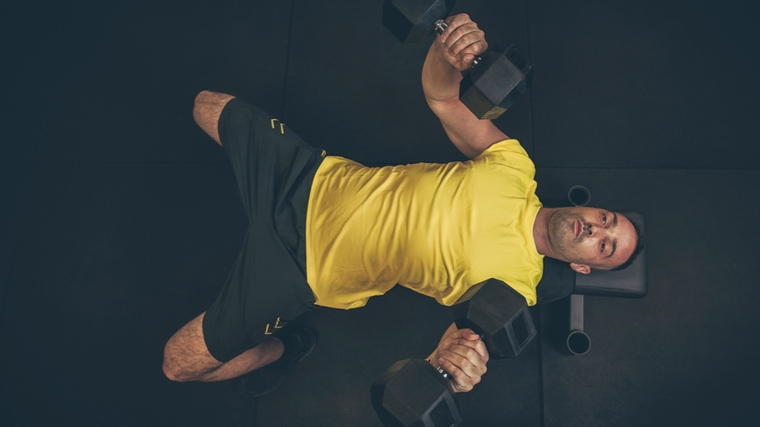
As you lie back on a flat bench, bring a pair of dumbbells to the outsides of your chest with your hands facing each other. Pull your shoulder blades back into the bench. Make sure that both of your feet are placed firmly on the ground, with your feet directly under your knees.
Your hips, your head, and both of your shoulders should be firmly touching the bench. Rotate your arms to point your elbows at an angle slightly away from your feet and allow your hands to point towards your knees.
Form Tip: For total stability, feel for six points of contact — two feet on the ground plus your tailbone, two shoulders, and your head on the bench. This will mean you are in a good position to start the exercise
Step 2 — Drive the Weights Up
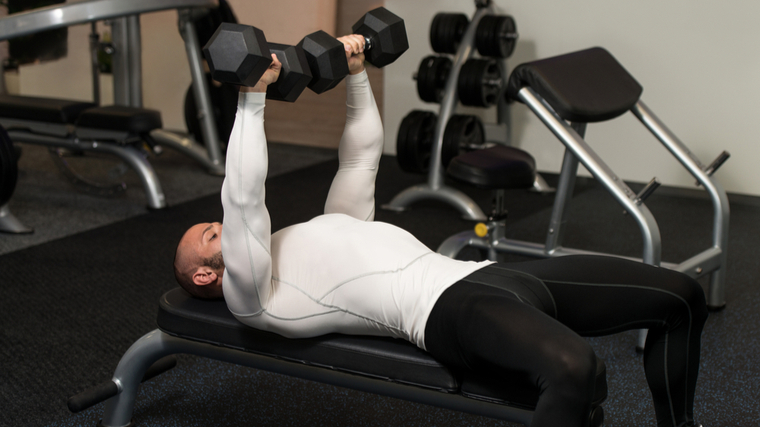
Hold the dumbbells firmly in a pronated (palms facing your feet) position with your wrists directly above your elbows. Drive your elbows up to the ceiling in a straight line until the dumbbells are positioned directly above of your pecs. Do not allow the dumbbells to touch at the top of each rep.
Form Tip: Make sure your elbows are stacked directly under your wrists before you drive up. Allowing your wrists, and the weights, to break the plane of your elbow will increase joint strain and increase the potential risk of injury.
Step 3 — Lower into a Stretch
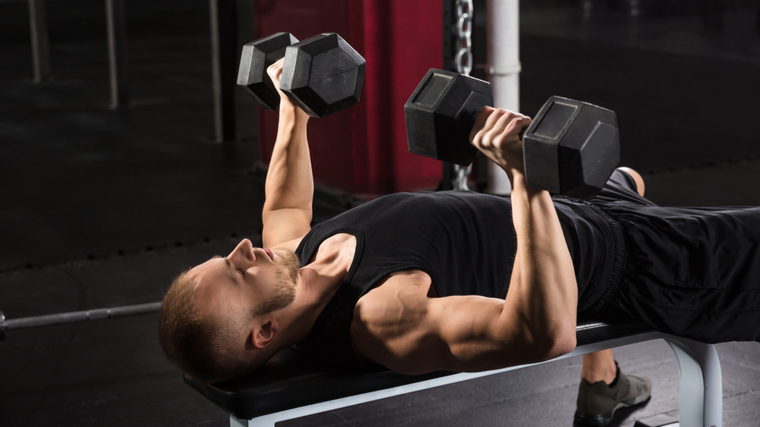
Slowly lower the dumbbells down while squeezing your shoulder blades into the bench. Keep your elbows pointed at an angle between your feet and your shoulders. Emphasize feeling your pecs stretch as the dumbbells come to a position resting just outside your chest.
Form Tip: Think about pulling the dumbbells toward you while reaching your chest to the ceiling.
Dumbbell Bench Press Mistakes to Avoid
When using dumbbells, increased freedom at the shoulder joint also means the exercise requires increased control and coordination. There are a few errors to avoid when performing the dumbbell bench press.
Having an Unstable Body
It is very common to see lifters place their feet in the air and cross their ankles or haphazardly sprawl their legs away from the bench during the exercise.
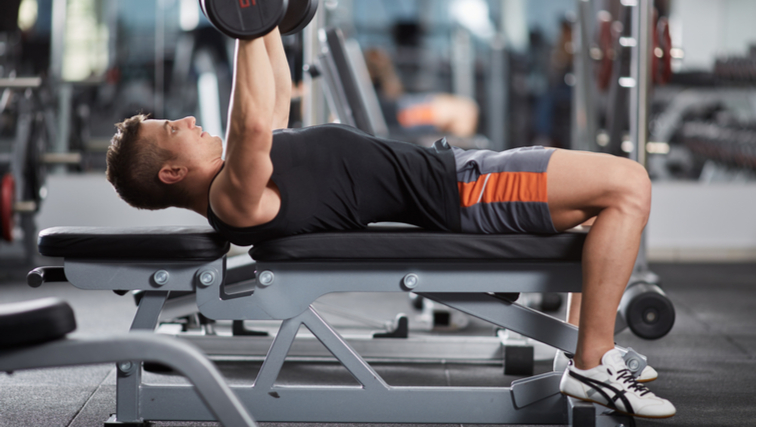
This creates an environment of instability and prevents you from being able to produce the most force, which compromises strength production because the lower body is an essential contact point and base of support.
Avoid It: Driving your legs into the ground will help maintain balance with the torso and allow you to create more force with the upper body. Your feet, calves, hamstrings, glutes, and quadriceps should all be tense and fully engaged.
Ego Lifting
Some lifters think that just because they can bench impressive weights with a barbell, they’re “supposed to” bench with heavy dumbbells, too.
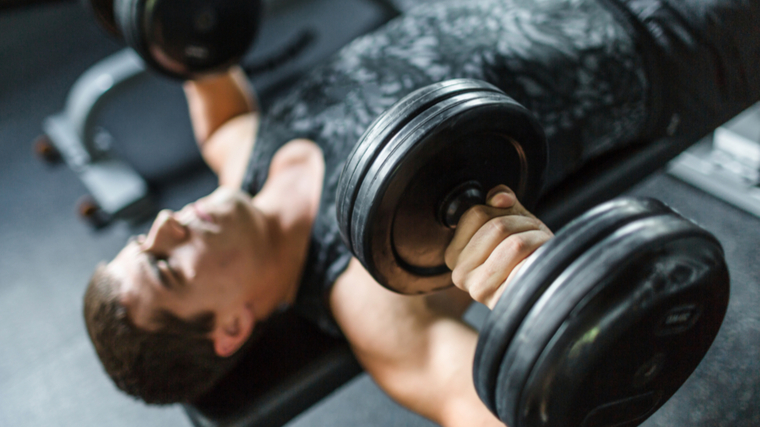
What they fail to realize is that dumbbells involve the smaller stabilizer muscles of the shoulder more than a barbell, which means excessively heavy weights can strain the shoulder joint and decrease chest muscle recruitment.
Avoid it: Lean the ego at home when it’s time to use dumbbells. Whatever you barbell bench press, cut that weight in half and then take off another 5-10kg (10-20 pounds). This will give you a good starting point for the total weight (both dumbbells combined) when learning the exercise.
Benefits of the Dumbbell Bench Press
The bench press is be a staple movement in nearly every lifter’s repertoire.
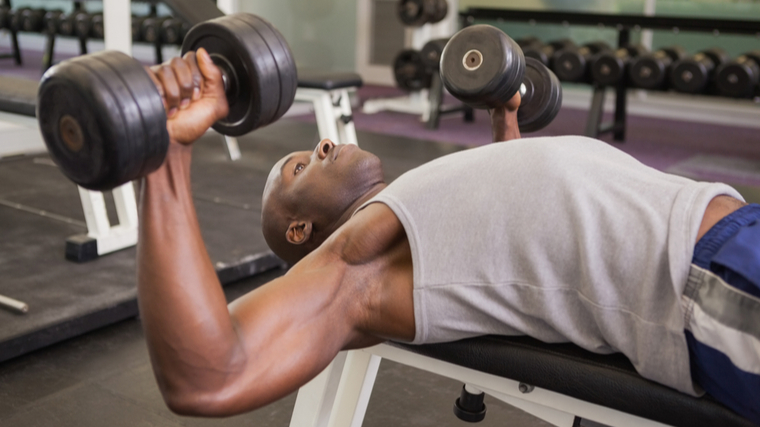
Here are two big advantages that dumbbells have over the barbell.
Greater Range of Motion
With a barbell, your hands and arms are set into fixed angles with relatively limited range of motion. Dumbbells allow the weights to move in an arcing path, relatively wider in the bottom position and nearly touching at the top.
This provides a longer range of motion as you lengthen the muscle with a deeper stretch which can increase your muscle building potential compared to a barbell. (1) Dumbbells also allow your hands to rotate, which can individualize pressing angles to reduce joint strain.
Unilateral Strength
Overemphasizing barbell training can create muscular discrepancies, since most lifters naturally favor one side more than the other. Because a barbell doesn’t allow each side to focus its own share of work, you may not notice the subtle differences in your unilateral strength.
Using dumbbells will allow you to build that unilateral strength and reduce any muscular imbalances from occurring while still strengthening your pecs, triceps, and shoulders.
Muscles Worked by the Dumbbell Bench Press
All chest presses focus the work, appropriately, on the chest. However, several muscle groups work together to perform the exercise.
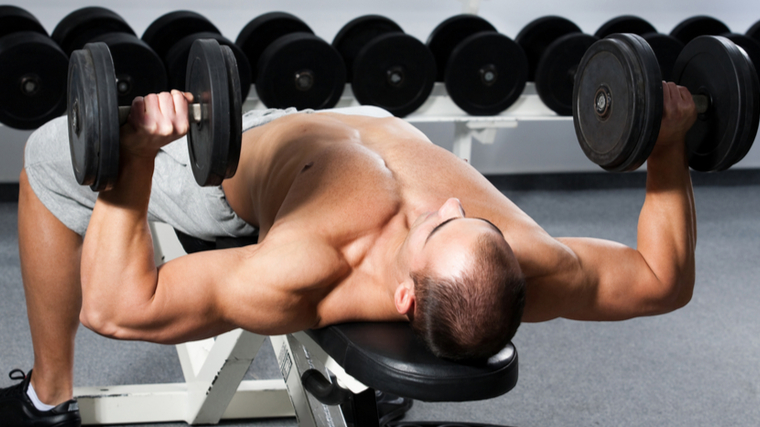
The dumbbell bench press allows lifters to train their pressing muscles (chest shoulders, and triceps) without excessively heavy weights.
Pectoralis Major
The pec major is the big, basic chest muscle. It includes two separate heads: the clavicular (upper chest) and the sternocostal (mid-chest). Both heads of the pecs function to pull the upper arms across the chest toward the midline of the body.
Anterior Deltoid
The shoulder muscles is composed of three separate heads — the posterior (rear), the lateral (side), and the anterior (front). Each head contributes to moving the arm in its respective plan, so the anterior deltoid is heavily recruited during the dumbbell bench press because the arm is moving in front of the body.
Triceps
The triceps consist of the long, medial, and lateral heads, each playing a role in extending the elbows and raising the arms. The medial and lateral heads, in particular, are emphasized during the dumbbell bench press to move the weight and straighten (lock out) the elbows.
Pectoralis Minor and Serratus Anterior
These relatively smaller muscles are both found near the pec major. They share similar functions, helping to control shoulder blade movement and stability during pressing (and chest flye) movements.
Who Should Do the Dumbbell Bench Press
Much like the barbell bench press, the dumbbell bench press can offer benefits to strength athletes, physique-focused lifters, and general fitness enthusiasts.
Bodybuilders and Physique Enthusiasts
Whether it’s a 220-pound bodybuilding monster, a lean Men’s Physique competitor, or a typical lifter wanting to improve their pec size and shape, the dumbbell bench press can be a key player in any chest workout.
The dumbbell bench press puts the pecs through a long time under tension with maximum muscle activation, leading to more muscle growth.
Strength Athletes
With the barbell bench press being a sport-specific lift for competitive powerlifters, using the dumbbell bench press as an accessory exercise allows the same pressing muscles to be trained without wear and tear on the joints from the barbell’s repetitive use.
Overhead strength athletes, like Olympic weightlifters and CrossFitters, can also benefit from the dumbbell bench presses ability to train more unilaterally and reduce muscle discrepancies, which leads to improvements in strength overall.
How to Program the Dumbbell Bench Press
The dumbbell bench press can be programmed using a variety of set and rep schemes. It can be performed as a primary exercise at the start of your workout or as a supplemental exercise to maximize muscle fiber recruitment during a session.
Heavy Weight, Low Repetition
To maximize strength, three to five sets in the four to eight rep range is a good place to start. Because of the dumbbell’s stability requirements, lifting excessively heavy with extremely low reps to failure isn’t safe or effective. You should be using a weight that has you finish each set with at least one to two reps left “in the tank” to avoid reaching muscular failure. A rest period of three to five minutes between each set will ensure you lift with maximum effort.
Moderate Weight, Moderate Repetition
For muscle building purposes, working for three to four sets in the six to 12 rep range will bump up your overall training volume of the pecs, which is beneficial for building muscle. (2) The multiple sets and reps also allow you to develop your bench press technique without excessive fatigue from heavier weights.
Low Weight, High Repetition
It could better to use a machine or cable-based machine when working with a higher rep target and being in a closer proximity to failure, because shoulder stabilizers can fatigue before the chest muscles. However, working for two to three sets in the 13-20 rep range is a great way to improve your technique without impacting any extra stress on your joints that may come about from using heavier weights.
Dumbbell Bench Press Variations
Below are several effective variations that can be used by coaches and athletes to keep training varied, progressive, and more finely tuned to a lifter’s needs.
Dumbbell Floor Press
As you may have guessed, the dumbbell floor press is a dumbbell bench press performed on the floor, without a bench. This deliberately limits your range of motion to prevent the weights from traveling down past your chest. This is ideal if you experience shoulder discomfort due to restricted mobility.
It can also helps to train the triceps and improve lockout strength because top-half of the range of motion, where the triceps are most engaged, is emphasized.
Dumbbell Foam Roller Press
Using a foam roller instead of a flat bench allows the scapulae (shoulder blades) to move more freely throughout each rep, which improves upper back and shoulder health.
The mechanics of this is surprisingly similar to that of a push-up and optimizes your natural scapulohumeral rhythm — the way your shoulder muscles and shoulder blades coordinate during movement. This improvement can lead to improved shoulder joint health and increased muscular engagement.
Single-Arm Dumbbell Bench Press
This exercise variation is great for improving total-body stability and unilateral strength while also improving core engagement. You simply use one dumbbell and perform the exercise with one arm for your target number of reps before switching sides.
Your core musculature is going to be targeted to a much higher degree due to the fact that you’re preventing your torso from rotating to far to one side. It is best to use comfortable weight when first taking on this variation and build your confidence remaining stable before increasing weight.
Dumbbell Bench Press Alternatives
If you’re looking for options beyond the dumbbell bench press, there are several effective exercises that work that upper body in a similar fashion.
Barbell Bench Press
While the dumbbell bench has many specific benefits, sometimes it’s appropriate to just load some weight and bench. The key difference with this exercise is its bilateral component, moving both arms together, which exactly what makes it a great way to load up the weight and focus on building strength.
However, the barbell bench press is not limited to purely a strength focus. It can be used to provide a significant amount of volume which triggers a greater muscle-building response. Performing it later in the workout, when the chest is fatigued from other exercises, is one very effective approach.
Seated Cable Chest Press
This may appear to be an unconventional exercise, but it’s very effective when executed correctly. Much like the dumbbell bench press, there is a unilateral factor involved which allows the shoulders freedom to move with reduced joint strain.
The adjustable height of the cable pulleys allows you to train at angles (simulating an incline or decline press) while remaining seated upright. Many gyms have a dedicated seated cable machine, but an identical movement can be performed placing a seated bench in the center of a two-pulley cable station.
FAQs
Can I perform the dumbbell bench press and barbell bench press in the same workout?
Yes, absolutely. Use the barbell bench press as a primary strength lift, performed with heavy weight and low reps, and use the dumbbell bench press as a hypertrophy-specific lift with light to moderate weight and moderate to higher reps. This will let you fully exhaust the muscle fibers with the increases range of motion that the dumbbell bench press offers.
How far should I lower the dumbbells?
Ideally, you’d lower the weights to the level of your chest, with your elbows slightly below the bench. However, you should focus on using your active range of motion, not the maximum range of motion regardless of pain or mobility.
If you cannot lower the dumbbells to achieve the deepest stretch of your pecs, or if you feel any discomfort that takes the emphasis off your pecs, then only move where you can maintain tension without pain. Regardless, always take your time to warm-up and physically prepare the muscles being used. Sometimes a thorough warm-up of your back, chest, and shoulders allows you to use a larger range of motion.
Rethink “Bench Day”
You wouldn’t solely rely on the dumbbell bench press to build a bigger and stronger chest, just like you wouldn’t (or shouldn’t) over-focus on the barbell bench. But when you take into consideration its benefits and versatility, it’s time to include this central exercise in your chest or “upper body pushing” workouts, with or without its barbell cousin.
References
-
Farias, D. A., Willardson, J. M., Paz, G. A., Bezerra, E. S., & Miranda, H. (2017). Maximal Strength Performance and Muscle Activation for the Bench Press and Triceps Extension Exercises Adopting Dumbbell, Barbell, and Machine Modalities Over Multiple Sets. Journal of strength and conditioning research, 31(7), 1879–1887. https://ift.tt/xlfb1UA
- Schoenfeld, B. J., Contreras, B., Krieger, J., Grgic, J., Delcastillo, K., Belliard, R., & Alto, A. (2019). Resistance Training Volume Enhances Muscle Hypertrophy but Not Strength in Trained Men. Medicine and science in sports and exercise, 51(1), 94–103. https://ift.tt/6dRuCkQ
Featured Image: Jasminko Ibrakovic
The post How to Do the Dumbbell Bench Press for a Bigger, Stronger Chest appeared first on Breaking Muscle.

0 Comments